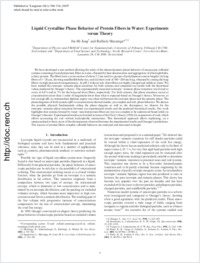Liquid crystalline phase behavior of protein fibers in water: experiments versus theory
- Jung, Jin-Mi Department of Physics and FRIMAT Center for Nanomaterials, University of Fribourg, Switzerland
- Mezzenga, Raffaele Department of Physics and FRIMAT Center for Nanomaterials, University of Fribourg, Switzerland
-
08.09.2009
Published in:
- Langmuir. - 2010, vol. 26, no. 1, p. 504–514
English
We have developed a new method allowing the study of the thermodynamic phase behavior of mesoscopic colloidal systems consisting of amyloid protein fibers in water, obtained by heat denaturation and aggregation of β-lactoglobulin, a dairy protein. The fibers have a cross section of about 5.2 nm and two groups of polydisperse contour lengths: (i) long fibers of 1−20 μm, showing semiflexible behavior, and (ii) short rods of 100−200 nm long, obtained by cutting the long fibers via high-pressure homogenization. At pH 2 without salt, these fibers are highly charged and stable in water. We have studied the isotropic−nematic phase transition for both systems and compared our results with the theoretical values predicted by Onsager’s theory. The experimentally measured isotropic−nematic phase transition was found to occur at 0.4% and at 3% for the long and short fibers, respectively. For both systems, this phase transition occurs at concentrations more than 1 order of magnitude lower than what is expected based on Onsager’s theory. Moreover, at low enough pH, no intermediate biphasic region was observed between the isotropic phase and the nematic phase. The phase diagrams of both systems (pH vs concentration) showed similar, yet complex and rich, phase behavior. We discuss the possible physical fundamentals ruling the phase diagram as well as the discrepancy we observe for the isotropic−nematic phase transition between our experimental results and the predicted theoretical results. Our work highlights that systems formed by water−amyloid protein fibers are way too complex to be understood based solely on Onsager’s theories. Experimental results are revisited in terms of the Flory’s theory (1956) for suspensions of rods, which allows accounting for rod−solvent hydrophobic interactions. This theoretical approach allows explaining, on a semiquantitative basis, most of the discrepancies observed between the experimental results and Onsager’s predictions. The sources of protein fibers complex colloidal behavior are analyzed and discussed at length.
- Faculty
- Faculté des sciences et de médecine
- Department
- Département de Physique
- Language
-
- English
- Classification
- Chemistry
- License
- License undefined
- Identifiers
-
- RERO DOC 17439
- DOI 10.1021/la9021432
- Persistent URL
- https://folia.unifr.ch/unifr/documents/301532
Statistics
Document views: 63
File downloads:
- mez_lcp.pdf: 250
